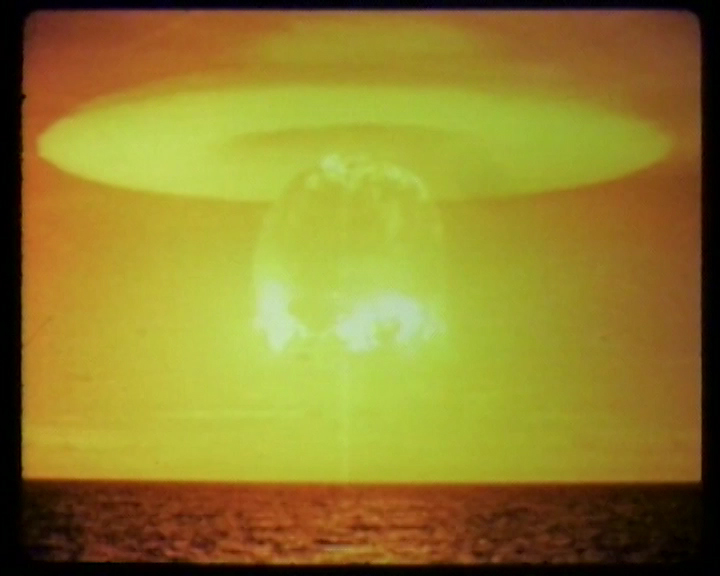


Linguistic summaries for „Operation Castle” (1954) film where possible machine analysis and description of moving image were examined. Framework for linguistic summaries using video mining algorithms was proposed. Image analysis based on machine algorithms was simulated on technical level. In a near future full analysis on both technical and symbolic, more abstract levels may be also considered. Hermeneutic character of the original footage was retained. The study of peripheral vision, technology development and politics.
Screenings
Open Genre, The Film and Video Poetry Symposium, New York, USA
There are no neutrals here, The Film and Video Poetry Symposium, Los Angeles, USA
Polymer Art Space, Taipei, Taiwan
Przewijanie taśm vol. 3 „Sabotaż: strategie subwersywne w kinie found footage”, Atelier WRO, Wrocław, Poland
'Negative Horizon’ The 5th Taiwan International Video Art Exhibition, Hong Gah Museum, Taipei, Taiwan
Torrance Art Museum LA, Los Angeles, USA
European Heritage Days, Athens Digital Arts Festival, Athens, Greece
31. Hamburg International Short Film Festival, Hamburg, Germany
16. Media Art Biennale WRO, Wrocław, Poland
New Heuristics, Galeria Imaginarium, Łódź, Poland
CologneOFF X, Total Art, The Research & Innovation, Ashram, India
European Media Art Festival EMAF, Osnabrück, Germany
CologneOFF X, Total Art, @ Damen und Herren e.V. Düsseldorf, Germany
International Festival of Digital Arts & New Media, Athens, Greece
Future Conditions: from reality to algorithm, Photokina, Cologne, Germany
Proyector, 7th Festival Internacional de Videoarte, Intermediae, Madrid, Spain
An urban film map, ArtWall Gallery, Athens, Greece
International Video Art Festival Miden, Kalamata, Greece
International Festival of New Film, Split, Croatia
Fonlad Digital Art Festival, Coimbra, Portugal
Darkroom, Fotofestiwal, Łódź, Poland
Operation Castle refers to the series of nuclear weapons tests conducted in the Pacific Rim by the United States in 1954 and the documentary project initiated by the Nuclear Regulatory Commission’s Armed Forces Special Weapons Project in the same year regarding the tests. Filip Gabriel PUDŁO, a Polish video artist, first renders the analog data of the visual information stored in NTSC VHS tapes to digital-coded format. Then he applies the framework for linguistic summaries using video-mining algorithms. Mechanically, image analysis based on machine algorithms was simulated on a technical level, including quantitative depictions such as color temperature, focus, luminance, and so on. PUDŁO describes Operation Castle as “linguistic summaries for ‘Operation Castle (1954)’. Without intonation and narrative content, the computer-generated voices contour a hermeneutic report of the material aspect of the moving image itself. The emptiness of the narration juxtaposes with the visual semiotics of the film, representing the scenes of nuclear weapons tests that are saturated with atrocious violence and heinous destruction. PUDŁO’s ontological scrutiny of the mechanical image makes the apparatus condemn its own unconsciousness of violence done in forms of movement.
2016 5th Taiwan International Video Art Exhibition
Proces abstrahowania w found footage’u służy również odmagicznieniu. Zadaniu pytania o to, dlaczego uchwycony przez obiektyw kamery obraz podświadomie rozpoznawany jest jako ślad rzeczywistości, forma niepodważalnego dowodu. W pracy Filipa Gabriela Pudło Operation Castle, głos z offu informuje widza o technicznych aspektach obrazu. Użyty algorytm komputerowy analizujący kolejne ujęcia zastępuje narratora komentującego przebieg testów broni jądrowej w tytułowej operacji. Odwraca uwagę od skali destrukcji widocznej w materiałach pozostawiając widza z milczącym obiektem posiadającym jedynie wymiary, barwę i technikę wykonania. Jego ideologiczna treść i orientacja zostają zawieszone i jakby nieme.
Maurycy Wiliczkiewicz, „Sabotaż: strategie subwersywne w kinie found footage”, Atelier WRO
Operation Castle (2013)
found footage single-channel video 4:3, color, sound










